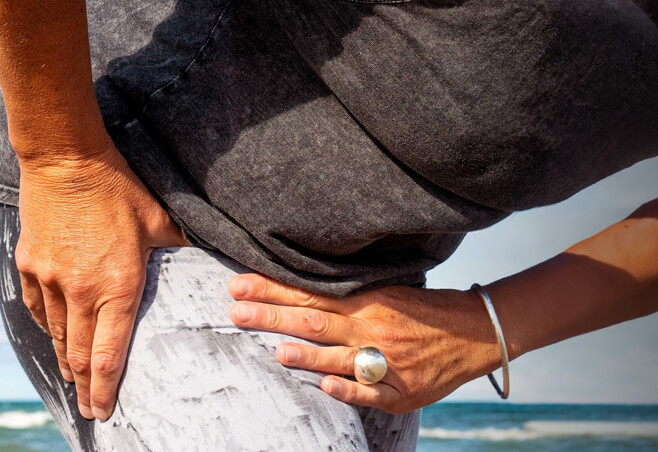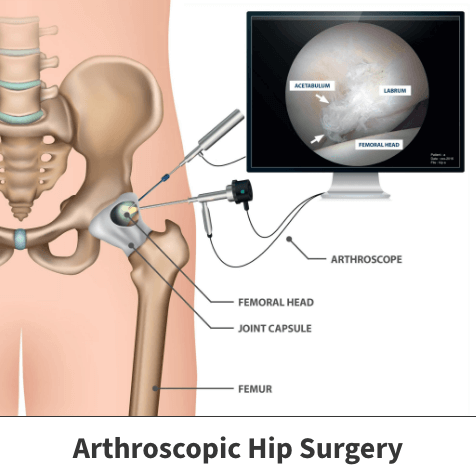Hip impingement & labral tears
Your hip is critical to your ability to stand, walk, bend, exercise, and perform many other movements. Injuries occurring here can result in significant pain, limited mobility, and the inability to complete many routine activities. One of the things that can cause these issues include labral tears brought on by hip impingements.
Anatomy
The hip is a large ball and socket joint connecting the leg and thigh bones. In medical terms, the hip’s socket is known as the acetabulum. The ball is called the femoral head because it is positioned at the top of the leg bone (the femur).
The labrum is a group of tissues covering the acetabulum. It enables the hip’s ball to move efficiently and without difficulty. Moreover, a healthy labrum ensures the ball and socket remain in place but never touch one another.
About
Labral tears can be the result of several different causes, including:
- Acute traumatic injury
- Age
- Obesity
- Chronic medical conditions like osteoarthritis, which gradually breaks down the cartilage surrounding joints.
- Congenital abnormalities – Some people are born with hip problems that can accelerate wear and tear of the joint and eventually cause a hip labral tear.
- Repetitive motions – Sports-related and other physical activities like long-distance running and the sudden twisting or pivoting motions from golf or softball can lead to joint wear and tear and ultimately result in a hip labral tear
One of the more common underlying factors is the unusual or abnormal bone contact in the hip. This is called femoroacetabular impingement, or more simply hip impingement.
When this problem occurs, your hip’s ball fails to fit into the socket properly. Over time, such events place pressure on the labrum, which might eventually cause injuries called labrum tears.
Symptoms
The pain and other associated symptoms you might experience will depend on how severe the tear is.
You can expect to experience things like:
- Pain in the hip region
- Discomfort that extends to your buttocks or groin
- A feeling of instability when you stand or walk
- A popping or clicking sound coming from your hip region when you move
These symptoms might worsen when you walk, bend down, swing the affected hip, exercise, or play sports. In some instances, hip impingement labral tears do not cause any symptoms.
Sometimes, if left unchecked, labral tears could result in significant immobility and further problems like osteoarthritis.

Diagnosis
An X-ray can usually detect hip impingements. These internal images of the hip typically show any hip abnormalities that could cause an impingement. Sometimes labral tears are only found with the help of a more sophisticated diagnostic device like a magnetic resonance imaging machine (MRI).
Treatment
Several factors will play into the specific treatment your doctor prescribes. They can include:
- Your general health
- Your age
- Your physical conditioning
- Your lifestyle and physical activity level
- The medications you take
- Your weight
- The extent of the bone deformity
- The tear’s severity
In most cases, milder injuries need less aggressive treatments than more moderate to severe tears or impingements. Additionally, you might be given more extensive therapy if your symptoms interfere with your everyday life.
Nonsurgical treatment options
Mild cases often improve following a period of rest. You can usually manage discomfort using over-the-counter non-steroidal anti-inflammatory drugs, abbreviated as NSAIDs. These include ibuprofen (Motrin, Advil) and naproxen (Aleve).
More moderate occurrences can benefit from the administration of more powerful pain-suppressing drugs like steroids. Your doctor might also recommend a course of physical therapy – supervised exercises geared towards helping you regain movement and strength of your hip and surrounding bodily structures.
Surgical Intervention
Corrective surgery is performed arthroscopically, which is a less invasive approach. Surgeons use a small device known as an arthroscope – a small instrument equipped with a small camera that allows them to view the hip’s inner workings.
The procedure first focuses on fixing any impingement causing bone deformities. This is critical because reshaped bones are less likely to impinge upon or reinjure the surrounding labrum. Once bone corrections are made, the second part of the procedure shifts towards repairing torn labrums.
In uncomplicated cases, you typically go home the day of the surgery. Full recovery is usually achieved in anywhere from four to eight months.

Videos
Related specialties
- Anterior Hip Replacement
- Avascular Necrosis (Osteonecrosis)
- Groin Strains & Pulls
- Hamstring Injuries
- Hip Arthroplasty
- Hip Arthroscopy
- Hip Dislocation
- Hip Flexor Strains
- Hip Fractures
- Hip Hemiarthroplasty
- Hip Muscle Strains
- Hip Pointers & Trochanteric Bursitis
- Iliopsoas Tenotomy
- Labral Tears of the Hip (Acetabular Labrum Tears)
- Osteoarthritis of the Hip
- Osteoporosis
- Pelvic Ring Fractures
- Piriformis Syndrome
- Sports Hernias (Athletic Pubalgia)
- Thigh Fractures
- Thigh Muscle Strains
